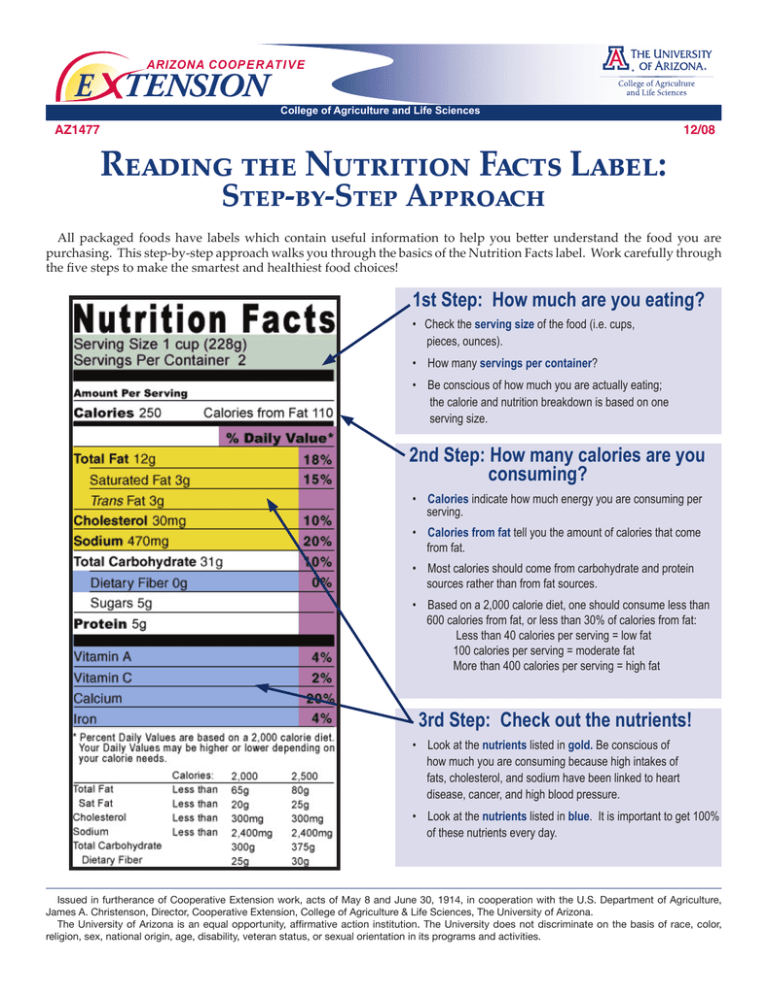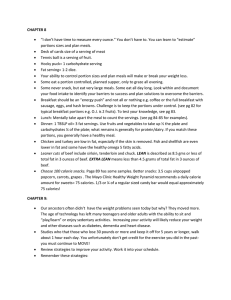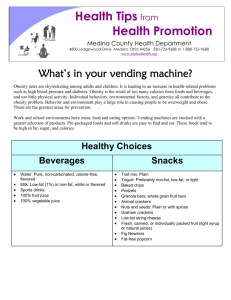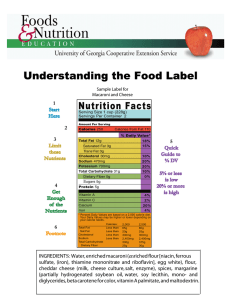Reading the Nutrition Facts Label: E TENSION Step-by-Step Approach
advertisement

ARIZONA COOP E R AT I V E E TENSION College of Agriculture and Life Sciences AZ1477 12/08 Reading the Nutrition Facts Label: Step-by-Step Approach All packaged foods have labels which contain useful information to help you better understand the food you are purchasing. This step-by-step approach walks you through the basics of the Nutrition Facts label. Work carefully through the five steps to make the smartest and healthiest food choices! 1st Step: How much are you eating? • Check the serving size of the food (i.e. cups, pieces, ounces). • How many servings per container? • Be conscious of how much you are actually eating; the calorie and nutrition breakdown is based on one serving size. 2nd Step: How many calories are you consuming? • Calories indicate how much energy you are consuming per serving. • Calories from fat tell you the amount of calories that come from fat. • Most calories should come from carbohydrate and protein sources rather than from fat sources. • Based on a 2,000 calorie diet, one should consume less than 600 calories from fat, or less than 30% of calories from fat: Less than 40 calories per serving = low fat 100 calories per serving = moderate fat More than 400 calories per serving = high fat 3rd Step: Check out the nutrients! • Look at the nutrients listed in gold. Be conscious of how much you are consuming because high intakes of fats, cholesterol, and sodium have been linked to heart disease, cancer, and high blood pressure. • Look at the nutrients listed in blue. It is important to get 100% of these nutrients every day. Issued in furtherance of Cooperative Extension work, acts of May 8 and June 30, 1914, in cooperation with the U.S. Department of Agriculture, James A. Christenson, Director, Cooperative Extension, College of Agriculture & Life Sciences, The University of Arizona. The University of Arizona is an equal opportunity, affirmative action institution. The University does not discriminate on the basis of race, color, religion, sex, national origin, age, disability, veteran status, or sexual orientation in its programs and activities. 4th Step: Which nutrients should contribute most to your diet? • The % Daily Value (DV) is based on 100% of the daily requirements of each nutrient (for a 2000 calorie diet) which can help you recognize nutrients that you are over consuming (20% or greater) and under consuming (5% or less). • Fat: Choose unsaturated fats (examples: olive oil, canola oil) when possible, and limit foods with saturated and trans fat (examples: saturated fat – butter; trans fat- hydrogenated oils). • Carbohydrate: Should constitute 60% of calorie intake, or about 1,200 calories or 300g. Look for low sugar and high fiber products. Try to consume at least 25g of fiber each day (1 slice of whole wheat bread = 2g fiber, ½ cup kidney beans = 8g fiber ) • Sugar: Limit sugar intake. • The daily value for calcium is 1,000mg a day. This product contains 20% (200mg) of calcium in 1 serving. 5th Step: What are the recommendations? • This sections shows recommended dietary advice relevant to all Americans based on either a 2000 or 2500 calorie diet. This is listed on every package, if space allows. This section will be the same on all food labels. • “Less than” indicates that you should consume less than the upper limit of the Daily Value of the nutrient. For example, you should consume “less than” 65g of fat or the total Daily Value for the day. • Use this as a guide to balance your diet. Any products, services, or organizations that are mentioned, shown, or indirectly implied in this publication do not imply endorsement by The University of Arizona. Now equipped with the necessary information, you too can shop smarter and healthier! ARIZONA COOP E R AT I V E E TENSION THE UNIVERSITY OF ARIZONA U.S Food and Drug administration http://www.cfsan.fda.gov/~dms/foodlab.html Insel, Paul, et al. Nutrition, 2nd Ed. 2004. COLLEGE OF AGRICULTURE AND LIFE SCIENCES The University of Arizona College of Agriculture and Life Sciences Tucson, Arizona 85721 Jamie M Wise, B.S. Undergraduate Research Assistant Nobuko Hongu, Ph. D., R. D. Assistant Professor, Nutrition Extension Specialist Department of Nutritional Sciences Contact: Nobuko (Kay) Hongu hongu@ag.arizona.edu This information has been reviewed by university faculty. cals.arizona.edu/pubs/health/az1477.pdf







